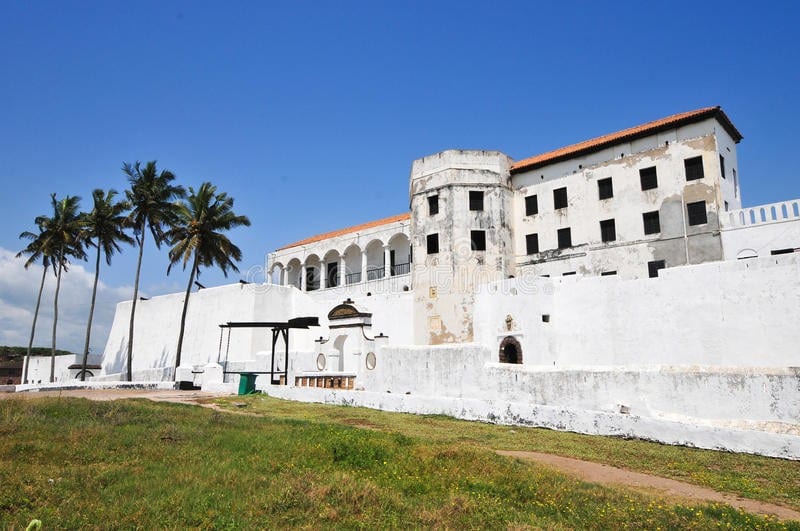Last week, I visited Ghana to give a talk at the New York University, Accra Campus and hold a writing workshop at the Goethe Institute for promising Ghanaian writers. Those events went well and I got the chance to catch up with old friends and writing colleagues.
Of course, being a Nigerian, it was easy to be caught up in the Jollof wars, or rather to throw oneself wholeheartedly into the debate. In the end, in good banter and humour, it was easy to proclaim the superiority of Nigerian Jollof, even if I am not a fan of rice, Jollof or otherwise. My Ghanaian friends argue that my verdict was based on samplings of “inauthentic Ghanaian Jollof.” This of course silences the fact that the Jollof I ate was made in Ghana by Ghanaians.
It was a visit that left many impressions and the one I suspect will linger the most are my memories of Elmina Castle, that infamous place where hundreds of thousands of Africans were housed in dungeons, abused, dehumanised and bundled on slave ships that took them away, never to see their homes or loved ones again.
The moment the car turned the corner and the castle, a grey, imposing edifice standing out against the blue of the sea and the blue of the sky, I could feel my heart clench and sink and a shadow of grieve whose weight I did not know until then spreading like a contagion.
When the Portuguese first arrived the coast of what is today Ghana in the 13th century to trade in gold and other commodities, they liked the idea of the place so much that they returned with 600 soldiers, two ships loaded with building materials and stood over the Fante king of the coast and demanded, but history said they asked nicely, for land to build a trading post. Gifts were offered and threats were made. Looking down the barrel of 600 guns, it was hard to imagine how this king could have said no.
The 600 soldiers turned builders and in 1482, erected what they would call the Castle of Saint George of the Mine. It would later be known simply as the Elmina Castle. For a few years, the Portuguese used it as a trading post, with warehouses for gold, ivory and whatever else they fancied. In later years, those warehouses will not hold gold and ivory but living, breathing, Africans. These men and women became the major commodity the Portugues and later the Dutch, who would seize the castle in 1637, would trade in. And Elmina became one of the most famous slaveholding and processing depot on the West African coast.
Millions of Africans rounded up from the various ancient kingdoms of the time were walked down to the coast, locked up in the dungeons of Elmina, sleeping on the hard stone floors and some dying on them. Every year for the next 300 years, 30, 000 slaves passed through the castle’s narrow “door of no return” onto the ships that would ferry them to the new world of the Americas and the Caribbeans.
These were just the numbers for Elmina. Nearby, the English ran the Cape Coast Castle, among the about 40 slave castles in the Gold Coast alone. It is estimated that 12.5 million Africans were shipped to the new world as slaves. Of these, 10.7 million made the crossing, the other two million died in transit and were thrown into the dark, cold belly of the Atlantic.
Elmina was a place of horror, pain and heartbreak. Yet, one of the most striking features of the castle is the smell. Especially in the female dungeon. The last slaves to pass through Elmina did so in 1814, the year slavery was abolished by the Anglo-Dutch Slave Trade Treaty.
Yet, almost 200 years later, that dungeon of the female slaves to this day oozes a gut-wrenching stench of misery. The tour guide explained that in that dungeon, those women hundreds of them were packed. They sweated, defecated, peeled and bled into the stone floor. They cried tears into those stones and died on them. So much that centuries later, the smell would not leave but attach with a renewed ferocity each time the sun is at its highest. What kind of wickedness stinks so bad that the stench clings to the stones for 200 years?
But perhaps nothing breaks one’s heart like standing at that narrow door of no return, looking out at the Atlantic, like the millions of men and women who have been forced through that door, some seeing the ocean for the first time in their lives, the sense of loss hits you. You knew that those forebears of yours who once stood there and walked through were filled with terror of the large body of water they see, of the unknown in its depths and the unknown that awaited them on the other side.
No person walks through Elmina, slave, pilgrim, historian, tourist or African and remains the same. The brutality committed there has guaranteed that. It leaves one, as it left me, emotionally overwhelmed, angry even. Some, like my travel partner, leave nursing a slow-burning rage for white people. Anger that manifested that day when we got to our lodgings, run by white people and encountered some problems with our bookings. You could see the rage rising in his eyes, in his voice and if he had not been pulled away, there was no telling what would have happened. Elmina messed with his mind.
Elmina was painful like that.
That evening, sitting on the beach looking at the white waves charging to the shores, it was impossible not to imagine them as a cavalry of horses coming to take more. More slaves. More Africans. More resources. And even when they crash and melt away on the shore, retreating like a beaten dog, it is impossible to let go of the pain. It is impossible not to question the complicity of the Africans who captured and sold their kins for little mirrors, beads, horses, gin and gunpowder. There on the shores of the Atlantic that ferried 12 million Africans across to doom, it is impossible not to wonder how such oppression could have been sustained for so long and for the scars, in the hearts of this continent, not to run so deep. No people can survive 300 years of the brutality that slavery is and be the same.
When questions of reparations are asked, it is not because it can heal the wounds of slavery, or make the pain disappear, or compensate those victims of that barbarity because they are long dead, nor will it compensate their descendants. It is because any civilization that profited from these centuries of abuse owes an eternal debt to those whose blood built their lands, those hands carved the legacy they inherit today and on whose sweat, blood and bones their lands and its riches are built. Yes, Elmina was painful like that.

 Join Daily Trust WhatsApp Community For Quick Access To News and Happenings Around You.
Join Daily Trust WhatsApp Community For Quick Access To News and Happenings Around You.


